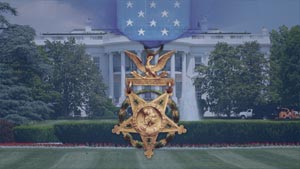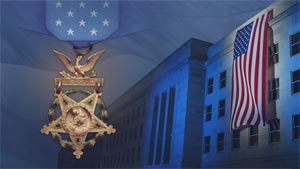MEDAL OF HONOR
Korean WarCorporal Fred B. McGee

hometown
Steubenville, Ohio
Enlistment date
May 1951
Military Occupation (MOS)
Infantryman (11B)
Unit
Company K, 3rd Battalion, 17th Infantry Regiment, 7th Infantry Division
Deployments
Korea, 1952
Cpl. Fred B. McGee — war hero, comic book superhero, native son, husband, dad and friend — was born on Memorial Day, May 30, 1930, to Spanish and Perrie McGee in Steubenville, Ohio. He was the sixth of eight children — six boys, two girls. Before his second birthday, the family moved from the bustling city to the bucolic beauty of Bloomingdale, where his Rockwellian life began in earnest. The land and its unpretentious, wood-frame homestead were the perfect backdrop for a new, albeit humble, beginning for the inquisitive toddler. In Bloomingdale, it seemed, young Fred had a safe place to grow and have a fair shot at the American Dream.
His mother told him from an early age, that he was born gifted and would do great things in life. His father, a self-taught mechanical engineer and business owner, invented and patented a snow tire chain that the Army would use on trucks in snow-covered Europe during WWII. One wintry day, while at home in Bloomingdale, five-year-old Fred watched intently as his father put snow tire chains on the family car. Not to be outdone, he found some rope, tied it around his tricycle tires and pedaled doggedly through the snow.
When McGee’s actions in battle were announced over the news feeds in the states, there was a wave of excitement. This was the Golden Age of comic books, and McGee was soon contacted by Heroic Comics, a Famous Funnies publication, for his permission to include his Hill 528 story. McGee wrote to his oldest brother, James H. McGee, a successful attorney back home, who told him “Go for it!” So, Cpl. McGee’s name and his actions were immortalized in the colorful pages of Heroic Comics.
After separation from active duty, he served in the Army Reserve for three years while resuming work at Wheeling-Pittsburgh Steel. An accomplished baseball player, he won the state batting championship with a .467 batting average. He had a tryout with the Kansas City A’s at a time when race was an issue. He coached and umpired both Little League and high school baseball and was a high school football referee.
In 2003 the former Cpl. McGee participated on a panel called “What Price Freedom? Contributions of the Disenfranchised” at the scholarly conference “No Longer Forgotten: African Americans & the Korean War,” which was held at Morgan State University and sponsored by the Department of Defense. He acted as grand marshal for the Veterans Day 10K Walk/Run in Wheeling, West Virginia, and other events, and has been interviewed by various media outlets.
He was inducted into the Ohio Military Hall of Fame for Valor, Class of 2002. The recipient of two Purple Hearts for wounds received on Hill 528, he was also inducted into the Purple Heart Hall of Fame in Newburgh, New York.
In 2009, the Congressional Medal of Honor Society, on National Medal of Honor Day, presented McGee with the Above & Beyond Citizen Honors Award for his leadership and “conspicuous selflessness and intrepidity in service to his fellow Americans by going above and beyond the call of duty in the aid of others.” In his civilian life, McGee continued to distinguish himself through his kind acts of selfless service and dedication to others. He loved his wife, Cornell Lewis, for 65 years. He loved to fish, hunt and spend quality time with friends and family. He loved to talk and whistle a happy tune. Whenever anyone dared question his ability to do something, with a youthful grin and twinkle in his eye, he’d say, “Don’t you know who I am? I’m Superman!”
 Fred and Cornell McGee wedding and wedding anniversary vow renewal in 2017 after 62 years of marriage. Courtesy photo.
Fred and Cornell McGee wedding and wedding anniversary vow renewal in 2017 after 62 years of marriage. Courtesy photo.
McGee was named Jefferson County, Ohio Service Commission Veteran of the Year for 2019-2020. Sadly, he was only able to live out three months of his term. As McGee was being laid to rest in early January 2020, Ohio Sen. Sherrod Brown took to the Senate floor with bold remarks in support of sustained efforts by veterans’ groups, concerned citizens and swelling ranks of fellow politicians clamoring for the correction of McGee’s Silver Star to the long-ago promised Medal of Honor. McGee was written into the Congressional Record in 2003, along with other brave patriots from the history books.
McGee lived a life of service to humanity. Now that he has received his much-anticipated Medal of Honor, his legacy is complete. A member of the Sons of the American Revolution, he is a direct descendant of thrice-deployed Revolutionary War patriot Henry Dorton (Dalton), who served honorably in Maryland, Virginia and Pennsylvania. Fred B. McGee was that shining light on a hill, that light that we are all called to be. From a hopeless bloody hill in Korea, to every hill and molehill within his own country, he was that shining light that dark forces of oppression could not dim.
 Then-Spc. Sonny B. Simpson, Sgt. 1st Class Graceon White, and Pfc. Fred McGee pose for a team photo while forward deployed in Korea. Courtesy photo.
Then-Spc. Sonny B. Simpson, Sgt. 1st Class Graceon White, and Pfc. Fred McGee pose for a team photo while forward deployed in Korea. Courtesy photo.
The Battle
Bravery in the face of bombardment
June 16, 1952 | Tang-Wan-Ni, Korea

7th Infantry Division
The shoulder sleeve insigia of the 7th Infantry Division. Read Full Unit History
Cpl. Fred B. McGee distinguished himself by gallantry in action near Tang-Wan-Ni, Korea, on June 16, 1952, during an assault on enemy fortified positions. As gunner on a light machine gun in a weapons squad, McGee delivered a heavy volume of supporting fire from an exposed position despite intense enemy machine-gun and mortar fire directly on his location.
Though forced to move his gun several times, he continued to support the assault and provide covering fire to the assault elements of his platoon. When his leader and several other members of his squad were wounded, he assumed command and moved the squad forward to a more exposed position to deliver neutralizing fire on an enemy machine gun.
When his machine gunner was mortally wounded, he again took over the gun. He then ordered his squad to withdraw and voluntarily remained behind to help evacuate the wounded and dead. Though wounded in the face, he heroically exposed himself by standing straight up under intense enemy machine-gun and mortar fire and attempted to evacuate the body of the company runner. Forced to abandon the body, he aided a wounded man and moved him to safety through a huge volume of enemy mortar and artillery fire.
McGee displayed conspicuous gallantry and intrepidity at the risk of his life above and beyond the call of duty. His unyielding courage and bravery, and his profound concern for his fellow Soldiers are in keeping with the highest traditions of military service and reflect great credit upon himself, his unit and the United States Army.
RELATED STORIES FROM ARMY.MIL
7th Infantry Division

7th Infantry Division
The shoulder sleeve insignia of the 7th Infantry Division contains an outline of an hourglass, alluding to the numerical designation of the division showing two 7s — one inverted, one upright.
The 17th Infantry Regiment was constituted in May 1861 as a unit of the regular Army. The regiment served in the Civil War, the Indian Wars, the Spanish-American War and the Filippino War before being assigned to the 7th Infantry Division in 1933, with whom they served in World War II and the Korean War.
The 7th Infantry Division was constituted in December 1917 as a unit of the regular Army. The division deployed in 1918 to France to serve with the American Expeditionary Forces. In October 1918, the 7th Infantry Division entered the front line. After the armistice ended fighting on Nov. 11, 1918, the division returned to the United States in 1919 and was inactivated two years later.
In July 1940, the 7th Infantry Division was activated at Camp Ord, California. In the spring of 1943, the division began its odyssey across the Pacific by recapturing two Alaskan islands from the Japanese. After refitting in Hawaii, the division conducted amphibious assaults at Kwajalein Atoll in the Marshall Islands, Leyte in the Philippines, and Okinawa. Following Japan's surrender in August 1945, the 7th Infantry Division moved to southern Korea to liberate the country from Japanese control. With the establishment of the Republic of Korea in 1948, the division joined the occupation force in Japan.
Immediately after North Korea invaded South Korea in June 1950, the 7th Infantry Division sent thousands of Soldiers to other divisions deploying from Japan to Korea. Rebuilt with replacements from the United States and thousands of Korean soldiers under the Korean augmentation to the U.S. Army program, the 7th Infantry Division landed at Inchon in September 1950. After the liberation of Seoul, the division sailed around the peninsula to land at Iwon in North Korea. In November 1950, its 17th Infantry Regiment reached the Chinese-Korean border at the Yalu River. That same month the Chinese launched a massive offensive that pushed United Nations forces out of North Korea and captured Seoul. A task force from the division was destroyed defending the right flank at the Chosin Reservoir. Back in South Korea, the 7th Infantry Division saw heavy combat in the drive north to the 38th Parallel from January to June 1951. For the next two years, the division fought a series of battles at outposts such as Heartbreak Ridge, Triangle Hill, Porkchop Hill and Old Baldy, until the armistice in July 1953. The 7th Infantry Division remained on the peninsula defending South Korea, which included clashes with North Korean infiltrators in the 1960s, until its inactivation in 1971.
The division was activated in 1974 and again stationed at Fort Ord. In 1985, the 7th Infantry Division became the first unit to transform under the light infantry division concept. Units from the division deployed to Panama for Operation Just Cause in 1989. The 7th Infantry Division inactivated in 1994 as part of the post-Cold War drawdown. Five years later, the headquarters activated at Fort Carson, Colorado, and led a new composite division of three Army National Guard brigade combat teams until its inactivation in 2006. In 2012, the division headquarters activated at Joint Base Lewis-McChord, Washington, to oversee the brigades stationed there. In 2015, the division’s headquarters deployed to Afghanistan for a one-year tour, assuming responsibility for the Train, Advise, and Assist Command – South mission.

